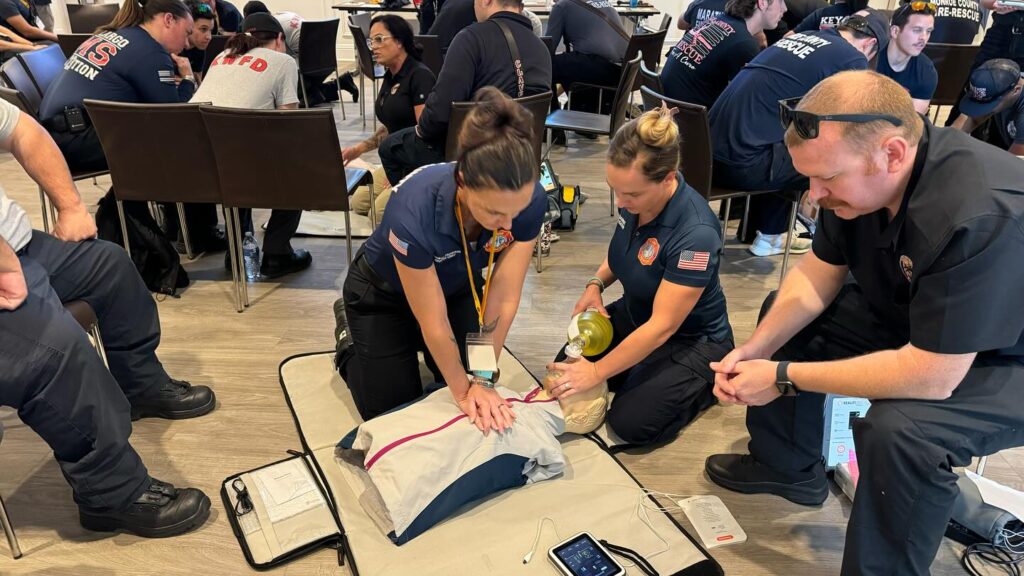
Photo/Monroe County (FL) Fire Rescue
Introduction
Cardiac arrest is a sudden, life-threatening medical emergency that demands a well-coordinated response to save lives. This article delves into the critical components of cardiac arrest resuscitation, with a particular focus on the essential roles played by emergency medical services (EMS) professionals during the prehospital phase. Additionally, we explore the profound significance of post-return of spontaneous circulation (ROSC) interventions and discuss the overarching objectives necessary to achieve success at the national level in managing cardiac arrest cases.
Cardiac arrest is a dire medical emergency where the heart suddenly loses its ability to beat effectively, resulting in an immediate loss of consciousness and vital signs. This underscores the critical need for rapid and effective intervention, making the prehospital phase a pivotal element impacting patient outcomes.
Successfully resuscitating a patient from cardiac arrest is the beginning of a challenging and complex journey. The post-resuscitation phase is a critical period characterized by potential complications and neurological concerns, further emphasizing the importance of a comprehensive approach to cardiac arrest management.
The Pre-Resuscitation Phase: Readiness for Success
Cardiac arrest management is a multifaceted process that begins even before the event itself. It involves meticulous pre-resuscitation preparations, ensuring that EMS personnel nationwide, along with the broader healthcare community are well-trained and equipped with the essential tools. Timely recognition of cardiac arrest, the initiation of high-quality cardiopulmonary resuscitation (CPR) and swift defibrillation are the cornerstones of effective management.
Recognizing the signs of cardiac arrest is fundamental for timely intervention. In many cases, the early signs and symptoms of cardiac arrest can be subtle and are often confused with other medical conditions. Educating healthcare providers, first responders and the general public to recognize these signs is crucial for a prompt and effective response. Identifying sudden loss of responsiveness, abnormal or absent breathing, and the absence of a pulse are critical indicators.
High-quality CPR, characterized by proper chest compressions with adequate depth and rate and minimal interruptions, is another vital element in the chain of survival. Effective CPR oxygenates the brain and vital organs, significantly extending the window of opportunity for a successful resuscitation. Furthermore, it helps maintain circulation until defibrillation can be performed.
Rapid defibrillation is a definitive intervention in specific types of cardiac arrest, particularly those caused by ventricular fibrillation or ventricular tachycardia. Automated external defibrillators (AEDs) have emerged as critical tools in this regard. Their placement in public areas, such as airports, shopping malls, and schools, has the potential to save numerous lives. Public awareness and education concerning CPR and AED use are pivotal components of effective cardiac arrest management, increasing the likelihood of early intervention and improving patient outcomes.
Public awareness campaigns, community training initiatives, and educational institutions teaching basic life support skills all play vital roles in caring for cardiac arrest patients. Empowering individuals with the knowledge and skills needed to respond effectively to a cardiac arrest situation can create a network of potential lifesavers within the community.
Furthermore, it’s crucial to highlight the role of telemedicine and technology in the pre-resuscitation phase. With advanced communication systems, paramedics can now receive real-time guidance from remote healthcare professionals, significantly enhancing the decision-making process during prehospital care. This telemedicine integration can improve patient outcomes by connecting paramedics with physicians or specialists for expert advice on complex cases, such as challenging airway management or medication administration.
The effective management of cardiac arrest begins with comprehensive pre-resuscitation preparation, including training and equipping EMS personnel, raising awareness about the importance of recognizing cardiac arrest, and initiating high-quality CPR. The placement of AEDs in public areas and educating the public on their use are also essential components of the broader strategy to improve patient outcomes. It’s a collaborative effort that involves healthcare providers, first responders, and the community, all working together to increase the chances of survival and enhance the quality of life for cardiac arrest patients.
Cardiac Resuscitation Phases and Consequences
Successfully reviving a patient from cardiac arrest marks the commencement of a challenging journey. The post-resuscitation phase is a critical period characterized by potential complications and neurological concerns. Effective post-resuscitation care is essential to manage these issues and optimize the patient’s long-term prognosis. This phase involves monitoring for neurological deficits, addressing organ dysfunction, and providing therapeutic hypothermia when indicated.
Return of Spontaneous Circulation (ROSC) and Immediate Post-ROSC Effects
Return of Spontaneous Circulation (ROSC) is a significant milestone in cardiac arrest resuscitation, representing the restoration of a functional heartbeat and blood flow. However, it’s essential to recognize that ROSC doesn’t guarantee a full recovery, and patients who achieve ROSC often face a multitude of challenges and potential complications.
One of the immediate priorities in the post-ROSC phase is to stabilize the patient. Achieving ROSC is only the first step. The healthcare team must work quickly to identify and address the underlying cause of the cardiac arrest, ensuring it doesn’t recur. This might involve further medical interventions, such as medications or procedures, to correct the root issue and maintain a stable cardiovascular state.
Ensuring adequate oxygenation and circulation is another critical task following ROSC. Patients may have suffered from a period of inadequate blood flow, which can lead to damage in various organs, most notably the brain and heart. Providing appropriate oxygen and maintaining circulation is vital to minimize further damage and promote recovery.
Moreover, it’s imperative to recognize that achieving ROSC does not guarantee that brain function has been preserved. Cardiac arrest often leads to a period of reduced blood flow to the brain, resulting in varying degrees of neurological injury. This phase involves continuous monitoring for neurological deficits, which may include assessments of consciousness, cognitive function, and motor skills. Identifying any neurological impairments and initiating timely interventions can significantly impact the patient’s long-term quality of life.
Exploring Personal and Organizational Transformations
While this article has focused largely on the technical aspects of cardiac arrest resuscitation, it’s crucial to acknowledge the human element in this life-saving process. Achieving success in cardiac arrest resuscitation is not solely reliant on medical expertise; it also hinges on personal commitment and programmatic changes.\
Healthcare providers must continuously train and update their skills to ensure that they can deliver the best possible care to cardiac arrest patients. Staying informed about the latest guidelines, technologies, and research findings is essential for providing the highest level of care. Continuous medical education, training, and skills development are pivotal in maintaining a competent and well-prepared workforce.
At the organizational level, healthcare institutions and EMS agencies should implement evidence-based protocols that reflect the latest advancements in the field. They should foster a culture of excellence, where healthcare professionals are encouraged and empowered to deliver the highest standards of care. Quality improvement programs should be established to monitor outcomes, identify areas for improvement, and implement changes that lead to better patient results.
Furthermore, collaboration and communication among healthcare organizations, EMS providers, and receiving hospitals are key elements in achieving a successful national approach to cardiac arrest management. Establishing standardized protocols and data sharing mechanisms can help ensure that best practices are consistently followed, leading to more positive outcomes for cardiac arrest patients.
Conclusion
Cardiac arrest resuscitation is a multifaceted process that extends beyond the initial response. Achieving ROSC is a significant milestone, but it’s only the beginning of the journey. Addressing immediate post-ROSC challenges, including stabilizing the patient, maintaining oxygenation and circulation, and monitoring for neurological deficits, is essential for long-term success.
Furthermore, a commitment to personal and organizational transformation is integral to improving the quality of cardiac arrest care. Healthcare providers should invest in ongoing education and training, while healthcare institutions and EMS agencies should adopt evidence-based practices, encourage a culture of excellence, and prioritize quality improvement.
In the quest to enhance cardiac arrest resuscitation on a national scale, the collaboration and coordination among all stakeholders, from paramedics to hospital staff, are paramount. By focusing on these elements and emphasizing their importance, we can work towards saving more lives and improving the quality of care for cardiac arrest patients throughout the nation. The dedication and competence of paramedics at the national level are pivotal in this collective effort.
Tristan Coomer is an experienced healthcare professional with a diverse skill set. He holds certifications as an advanced care paramedic, advanced care community paramedic, firefighter, educator and has the opportunity of sharing his experience and knowledge globally.



Great article. I ask that you consider this. As you know, cardiac arrest is a life-threatening medical emergency that can result in irreversible brain death after ten minutes (600 seconds) if the victim does not get help. Getting help is a time consuming process that starts with a caller accessing the 9-1-1 system, the 9-1-1 Center processing and dispatching the call, and the first responder crew(s) reacting to the alert and traveling to the emergency. The arrival of an ambulance in less than 600 seconds is not realistic in many EMS systems. When an out of hospital cardiac arrest occurs,… Read more »